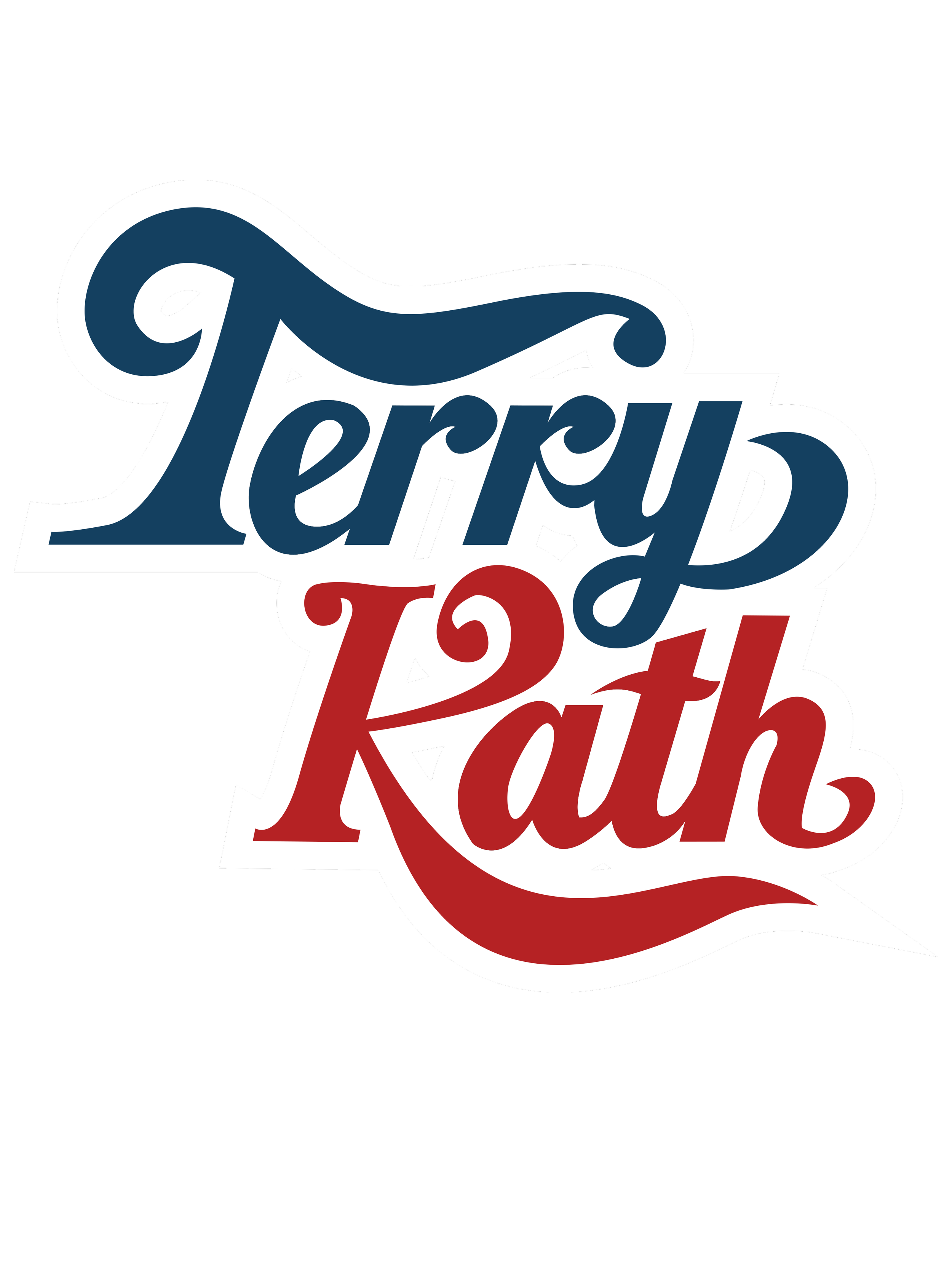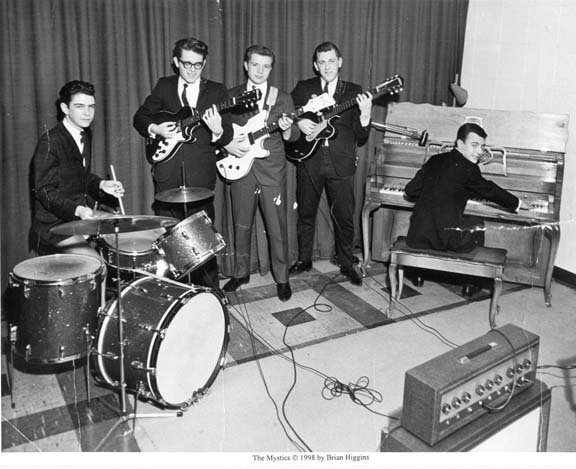The Mystics - Terry Kath's first rock band
The Mystics - from left: Denny Horan, drums; Brian Higgins, rhythm guitar; George Slezak, bass guitar; Terry Kath (deceased), lead guitar; Mike Pisani, piano. This photo was taken at an early-1960s recording session.
Photograph copyright 1998 Brian Higgins. Used by permission. Reproduction prohibited.
The Mystics - Terry Kath's first rock band
Story by Tim Wood
Although Brian Higgins could not have predicted that Terry Kath would become the guitarist for one of the great rock bands of all time, he knew that his best friend and bandmate was someone special.
In the early 1960's Higgins, Kath and three other teenagers were members of a Chicago-area band known as The Mystics. The instrumental band was inspired by The Ventures, then a very popular band known for hits such as "Walk, Don't Run."
Like many other bands in the area, they played their share of dances, VFW Halls, clubs and other venues. But unlike other bands, something different happened when they played. People stopped dancing and listened.
The Mystics occasionally played at the now-defunct Holiday Ballroom Dance Hall on Chicago's Northwest Side, which opened up to teen-agers one night a week. Usually, 90 percent of the kids danced, while the rest watched whatever band was playing. "But when Terry played, 70 percent of the kids watched," said Higgins, who was the band's other guitarist.
Higgins' relationship with Kath pre-dated the Mystics. Their parents attended the same church, they lived only a few blocks away in the Northwest side Chicago, and they first met when they were small children. They became close friends about the time Higgins was in sixth grade. Higgins' love of music, inspired by his friendship with Terry Kath, led to the formation of The Mystics, a group in which Terry frequently played. Other members of the Mystics included Denny Horan on drums, George Slezak on bass guitar and Mike Pisani on piano. Kath played with the group on and off, and also performed with other groups.
The run of the band lasted about four years playing one to two shows a week. They had a connection with the Buckinghams, a Chicago-area band that would achieve some chart success in the 1960s and who would be managed by James William Guercio. Guercio would also become the manager and producer for Chicago through the band's first 11 albums.
For a short time, the Mystics had the same manager as The Buckinghams before the Buckinghams were managed by James William Guercio. Guercio never had any connection with the Mystics though the bands occasionally played at the same venue on the same night.
One evening the band was booked to play a Polish Wedding, they didn't know any polkas. Kath told his bandmates to play certain chords on his signal. Kath then improvised polkas on his guitar, and the performance was well received. This is just one of his talent and versatility.
The long-term friendship between Higgins and Kath allowed insight into the development of Kath's unique style of playing. "Terry had an ear for music," Higgins said. Kath played piano, banjo and drums, in addition to guitar and bass. But while Higgins and others played music because "it was the thing to do," Kath was highly motivated. "From the eighth grade on, Terry knew he was going to be a professional musician," Higgins said, adding that Kath was intently focused on the goal.
Kath would usually decline offers to hang out with his friends after school and would instead practice. He would play for two to three hours, often by himself in a small room in the basement of his house. He had a small stereo set up in the room and he would learn songs off of records, Higgins said. Those records included jazz guitarists Wes Montgomery and Howard Roberts. A guitar magazine once described Kath's solo on "25 or 6 to 4" as "Wes Montgomery meets Jimi Hendrix." Higgins agrees with that description, but is quick to add that the Wes Montgomery influence came first.
Kath's interest in jazz was evident in his choice of instrument. Many young guitarists of the day longed to own and play the solid-body Fender guitars used by the Ventures. Kath ultimately used Fender and Gibson solid-body guitars, but his instrument in The Mystics was a hollow-body Gretsch Tennessean, a guitar more suited for jazz, Higgins said. "He did a lot of work on that guitar. No one but him could play it without it buzzing," Higgins said. Kath used light gauge, "slinky" flat-wound strings for a mellow tone. Higgins believes Kath established the foundation of his style on that guitar by listening to Roberts and Montgomery. Kath also was a big fan of The Beatles, he said.
"His ear was so good he could play note for note with the record," Higgins said. Kath could hear a simple song once and play it back almost immediately. More complex songs might take Kath and hour to learn and play back.
Higgins would like to clarify one common misconception about Kath - that he could not read music. "Terry could read music in a basic way," Higgins said. Kath could not read music as complex as that performed by Chicago, but he certainly learned it by ear.
Kath's good ear came in handy at Taft High School, where he and Higgins attended. He needed to take a music class to fulfill his course requirements and chose band. There aren't guitar players in concert bands, so Kath played the upright bass, the strings of which are tuned to the same pitches as a guitar. He managed to get through band despite his limited music reading skills.
Kath and Higgins both took lessons from Stu Pierce, a Chicago-area studio musician. Terry, who was a year older than Higgins, would drive them to Pierce's studio and they took back-to-back lessons. Kath took the lessons to learn chords, structures and riffs, Higgins said.
The Kath style is evident on a recording done by the band. Higgins estimates the date of the recording as early 1963, which would mean Kath was 17 and Higgins 16 at the time of the recording.
The band recorded four songs at Balkan Studios in Cicero, Ill. One song was an instrumental done in the style of Chuck Berry's groundbreaking rock and roll music. Another song was an extended jam based on the chord progression in the rock classic "Louie, Louie." Another band-produced composition was "The Floater," the only song on which Higgins plays lead instead of Kath. "Terry's rhythm playing was the best part of that song," Higgins said.
Interestingly, Higgins' favorite cut of the four was an impromptu jam session that would be called "I Don't Care." The recording engineer asked the band to just play some music, presumably so the engineer could adjust his equipment. The tape was rolling, though, and both the engineer and the band were quite pleased with the result. About 10 seconds before the end of "I Don't Care," a high-pitched whistle can be heard. It's not a recording defect, Higgins said. It is Kath signaling that eight bars are left in the song. About two years ago, Higgins learned that Kath used the same type of signal on stage with Chicago.
At the session, vinyl record copies were made of the recordings. These copies were not the same type as the mass-produced commercial releases of the day. They were produced directly off of the master tapes. Two records, each with two songs, were made. Higgins' copies survived more than 30 years of moves and storage. In a move two years ago, he put aside the records and photos of the session in a box that he was to transport himself and not put with the boxes to be moved by the moving company. But when he tried to find the recordings, they were nowhere to be found. Higgins spent two days going through 50 boxes that he had not opened since the move. He still could not find the recordings, although he found the photographs of the session. He walked away from his search, hoping for a fresh perspective. But he never could let it go.
In a desperate search he again looked at the boxes he had kept separate from the movers. When he searched a particular box for the third time, he found the records underneath a piece of cardboard. Despite the fact that the records had sat in that box unprotected for more than 30 years, the recordings played without a skip. There are the sound artifacts common to vinyl records, pops and hisses, but the music survives. Higgins is investigating the best way to make the best recordings of the session available to those interested in Kath's playing. At this time, copies of the recordings are not available for sale or trade.
Higgins believes the session is the first recording of Kath's guitar playing. Kath's first commercial recording would come later, when he recorded with Jimmy and the Gents, also known as Jimmy Rice and the Gentlemen, on the defunct Louis Prima label. This recording, which featured Higgins' brother Dave on drums, was a good recording, but was not a commercial success, Higgins said.
Kath went on to play with Jimmy Ford and the Executives. Higgins sat in with both the Jimmy Rice and Jimmy Ford groups during several rehearsals, but was not a member of those bands. As Kath pursued his musical career, Higgins chose to go to college. Higgins and Kath began to drift apart.
When Kath moved to Los Angeles with the rest of the Chicago Transit Authority, Higgins would not see him again until around 1972, when the band, now known as Chicago, made a triumphal return to Chicago. At that time, Higgins, Kath and their wives got together at the Green Bag on Milwaukee Avenue to talk about old times.
Higgins presently works as a business consultant in Atlanta, Ga. About a year ago, Higgins started playing guitar again and bought a Fender Stratocaster, a guitar he had wanted as a teen-ager. Kath also used a Stratocaster for much of his work with Chicago. Higgins thinks of Kath every time he picks up the guitar.
The Mystics survive today in the form of two photographs and two old vinyl records. Higgins would like to track down the two other surviving members of the band. The Mystics may never reunite. But for Higgins, the memories of playing with a legendary guitar player are still vivid - and priceless.


